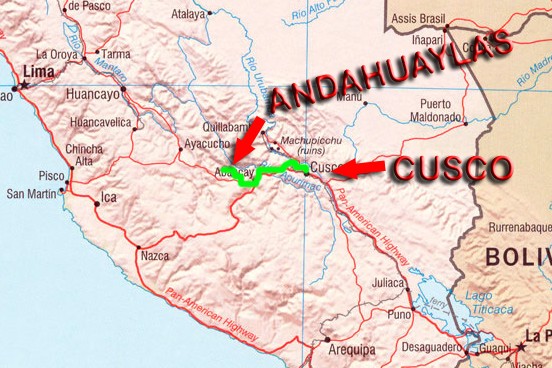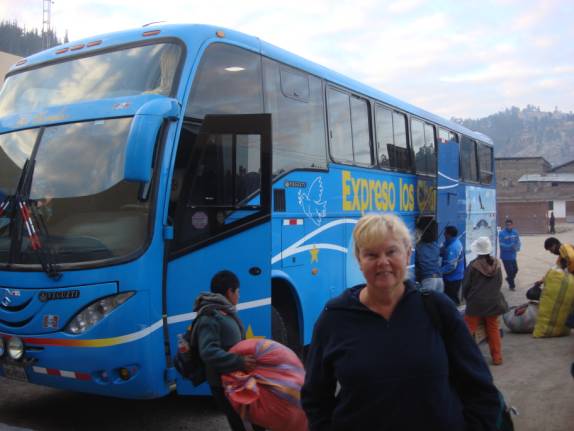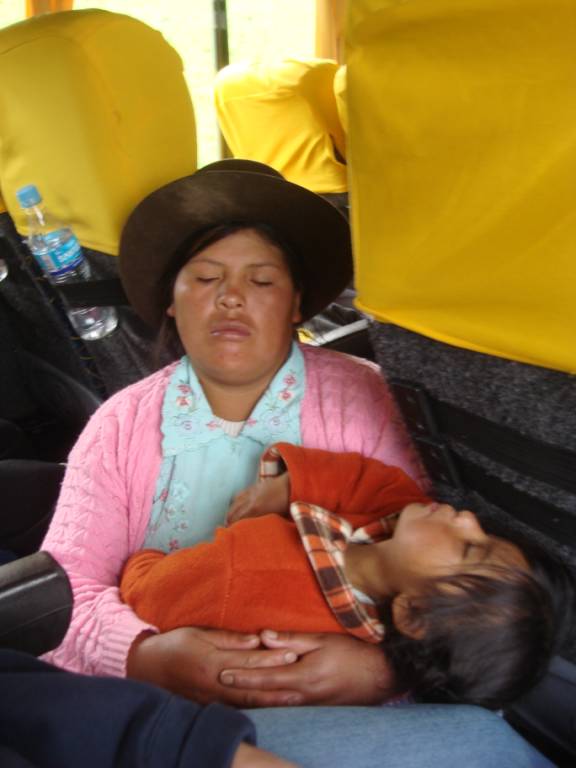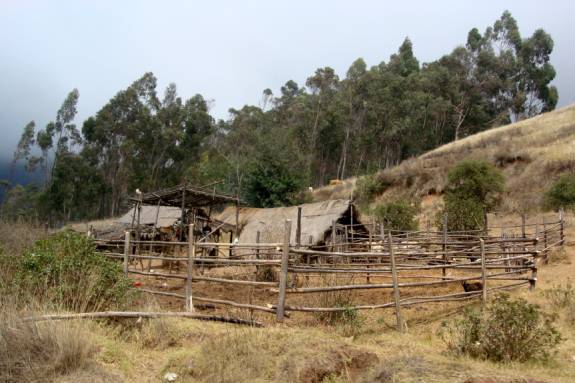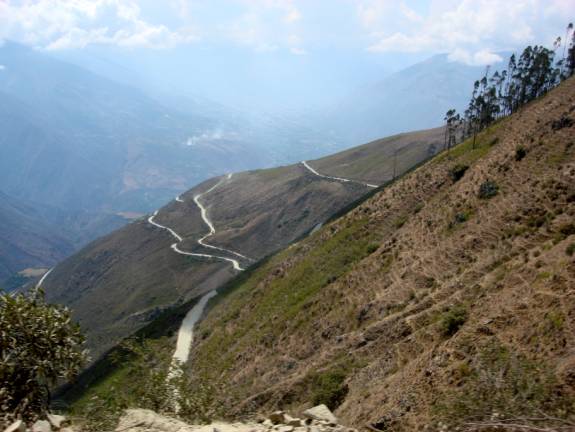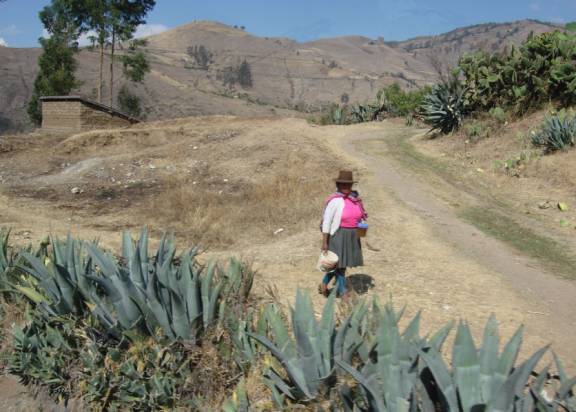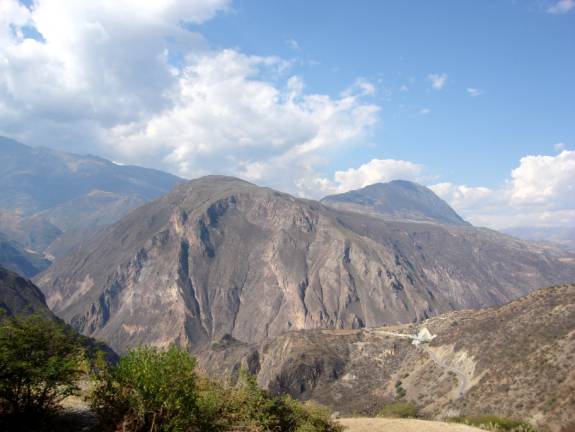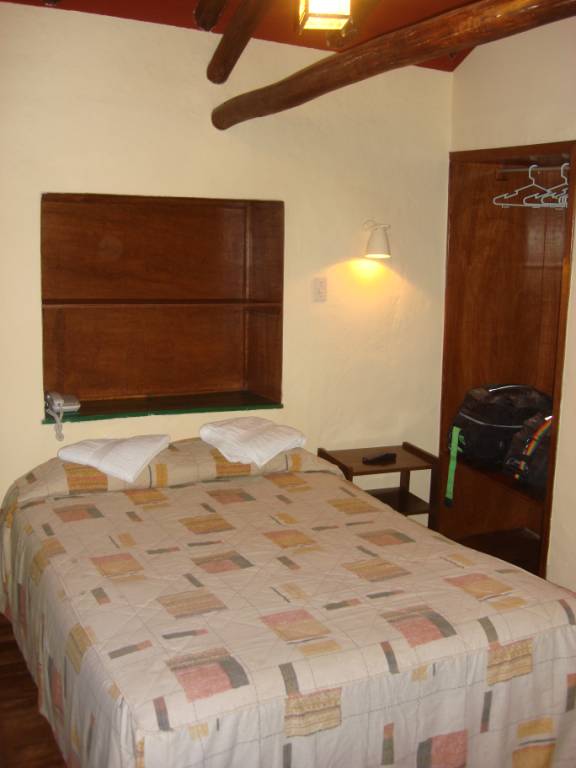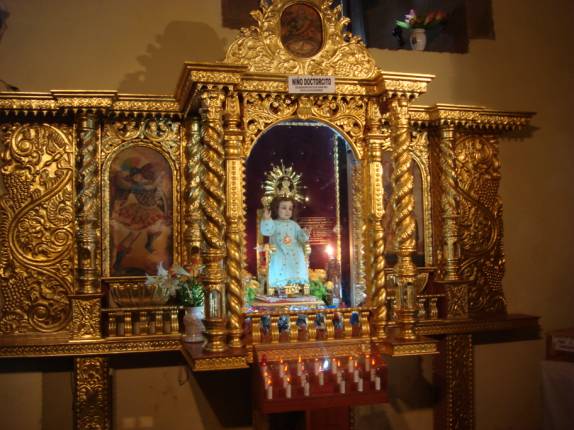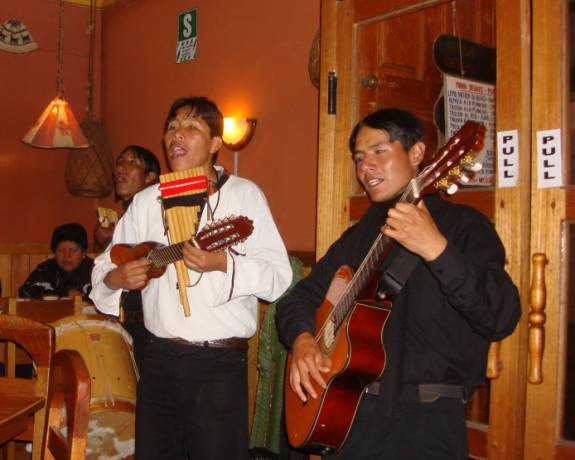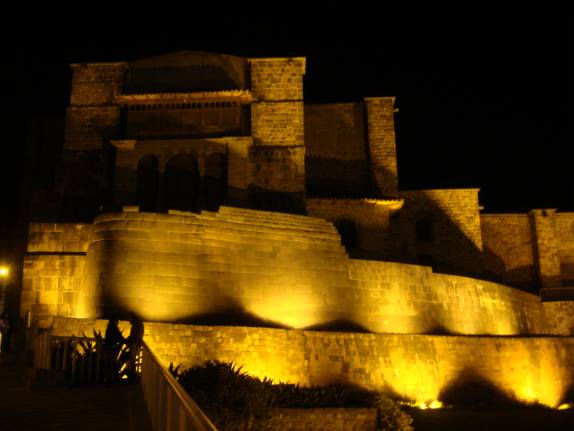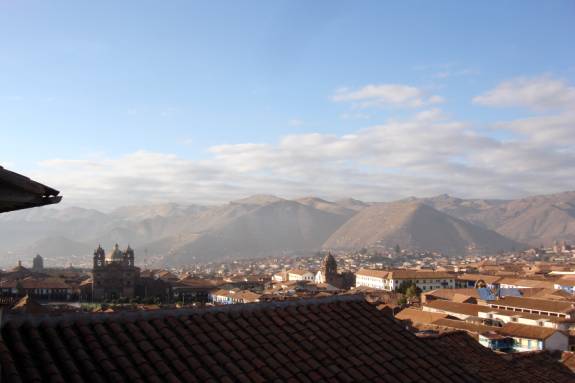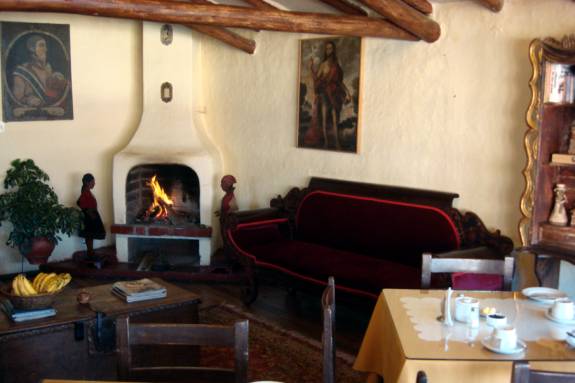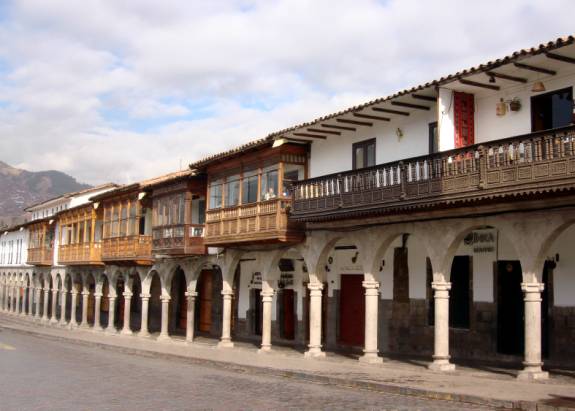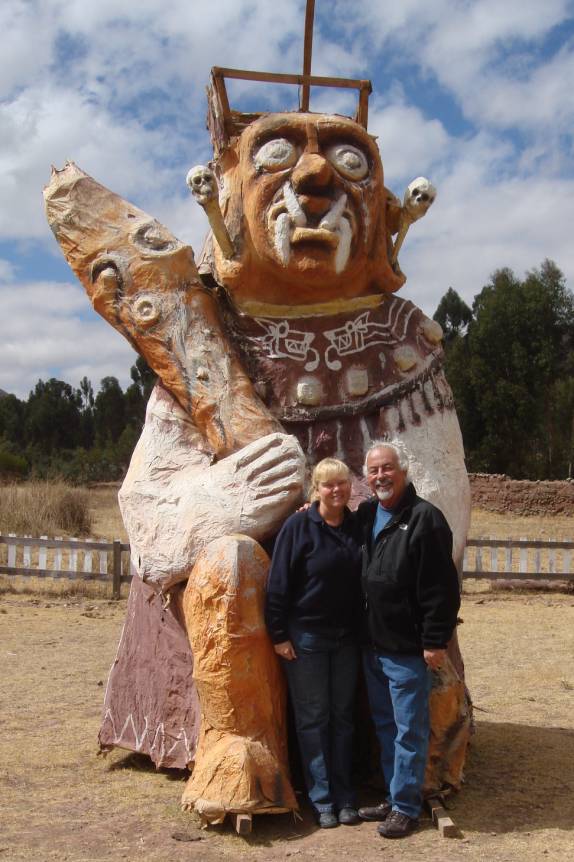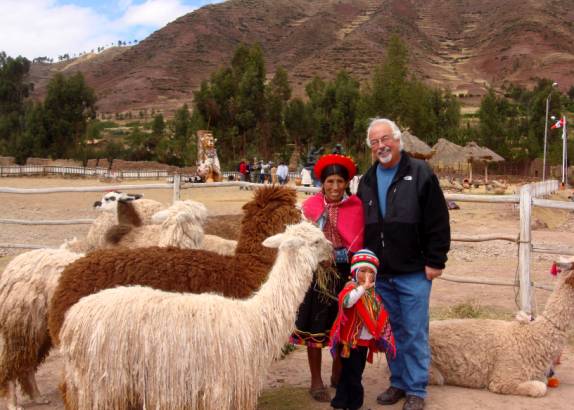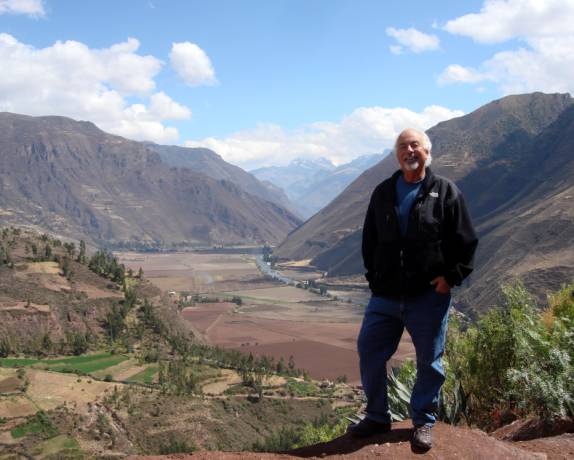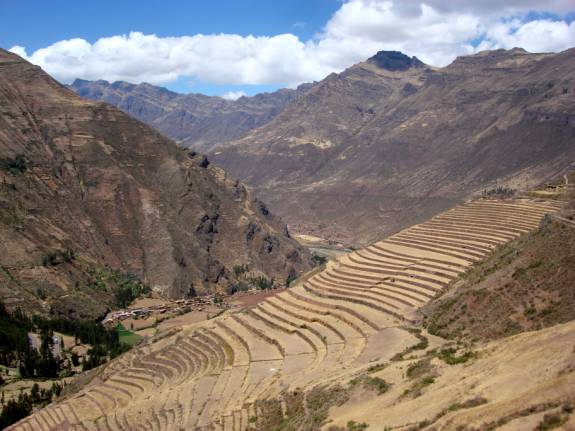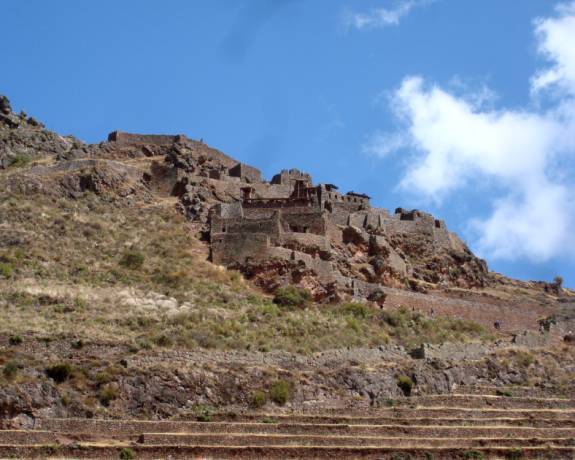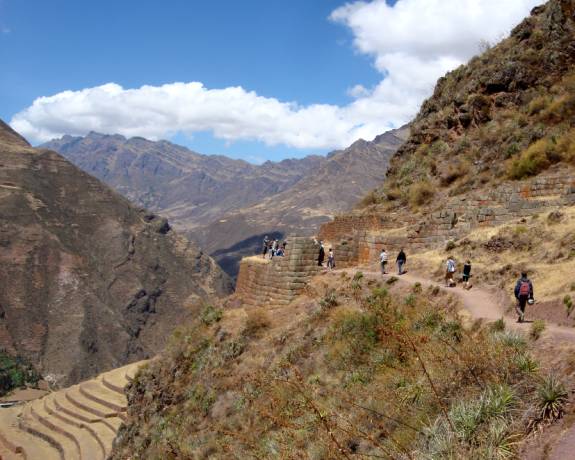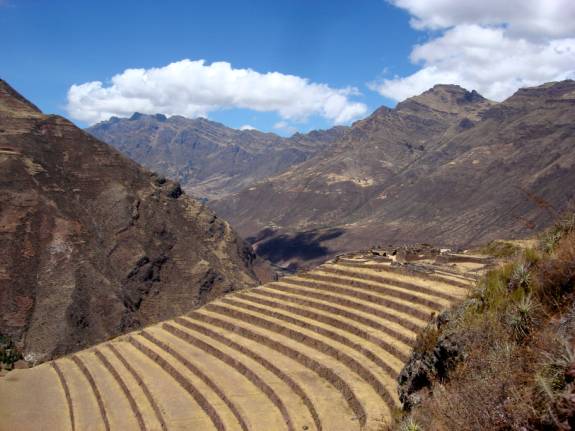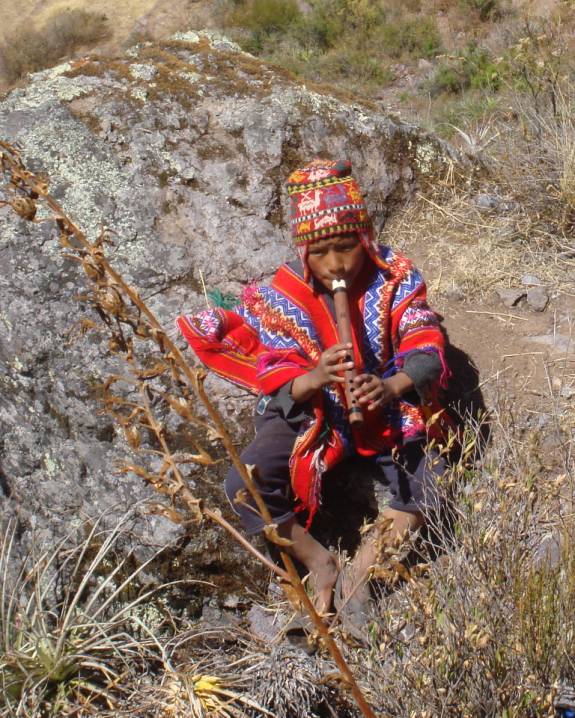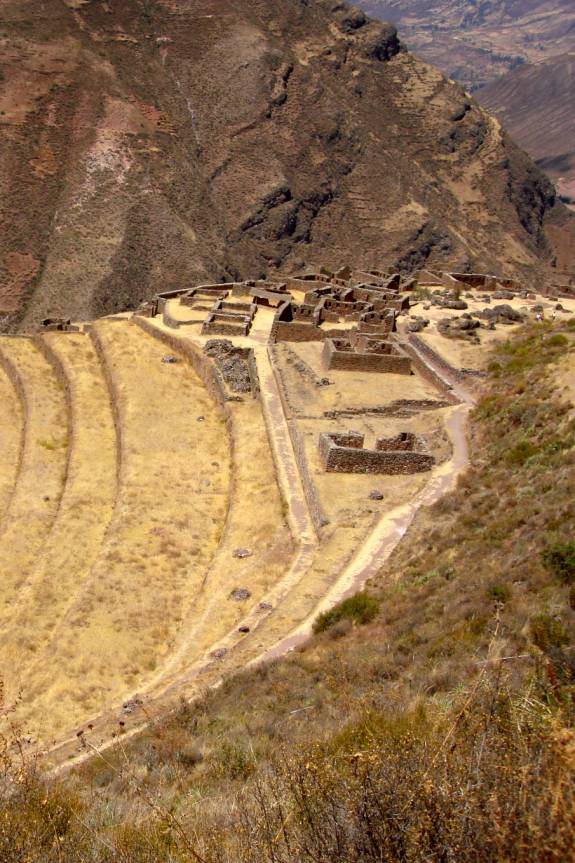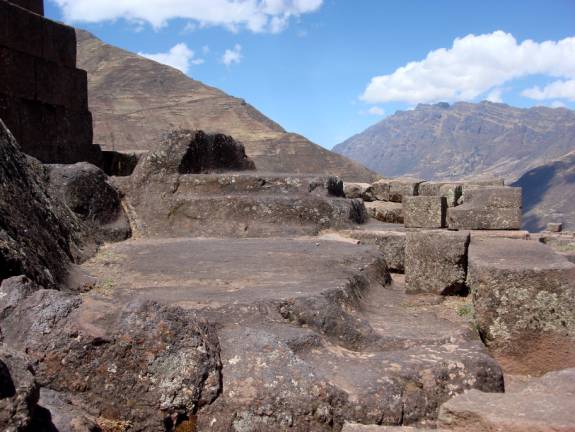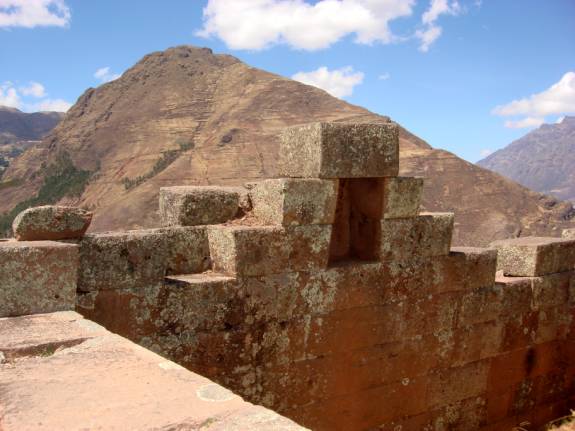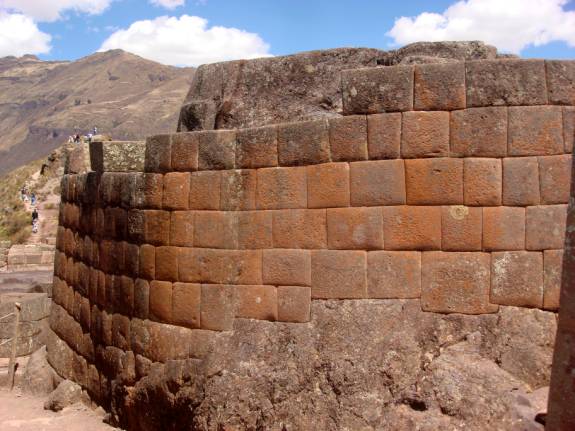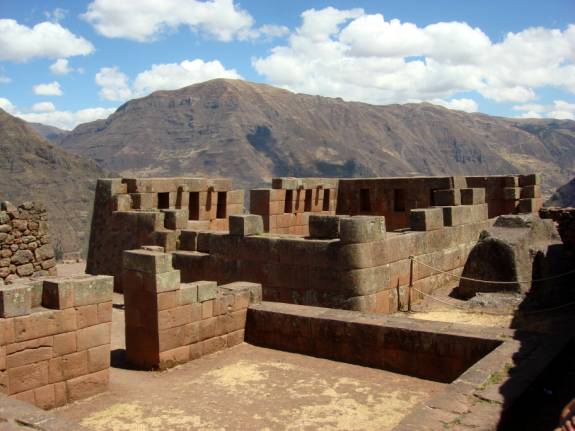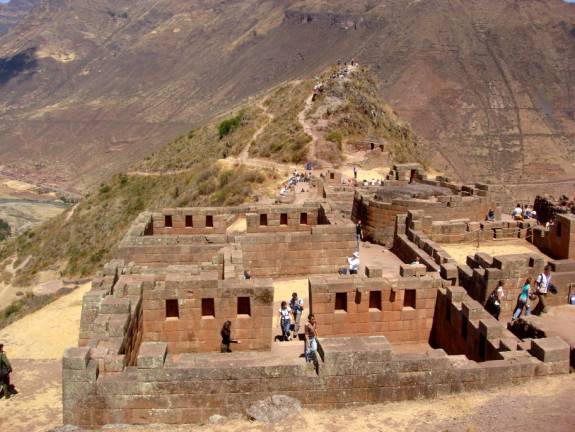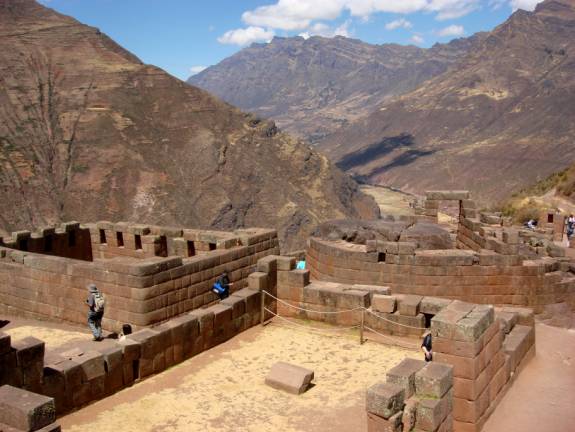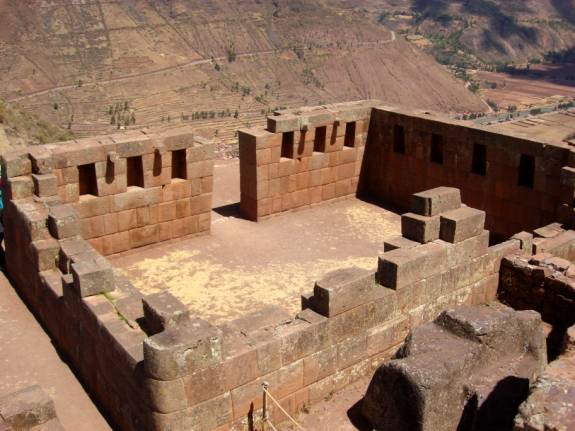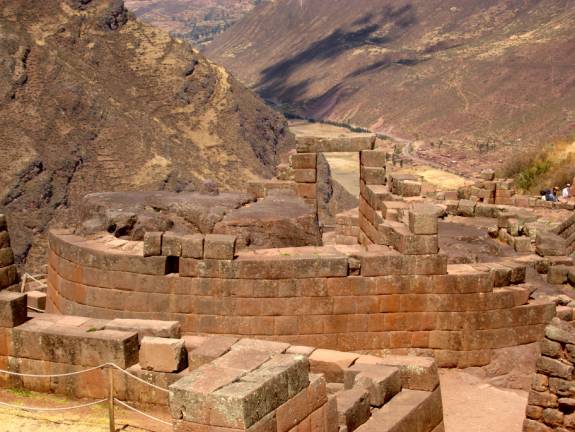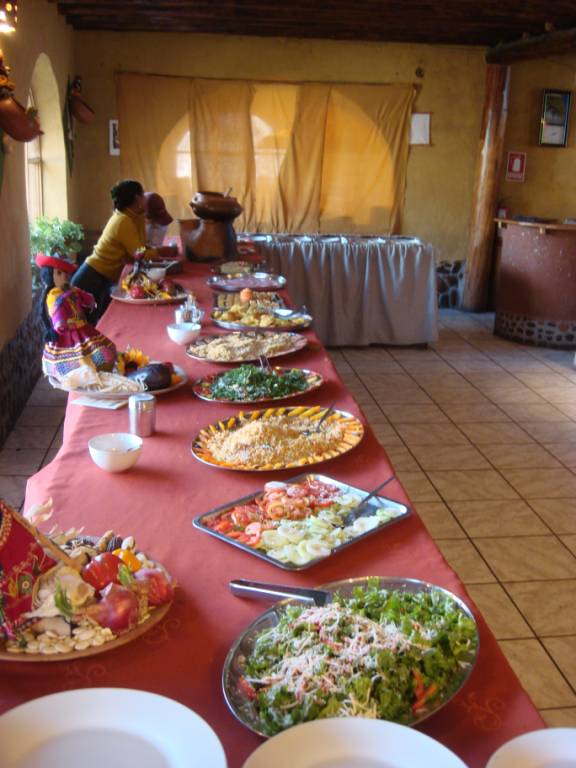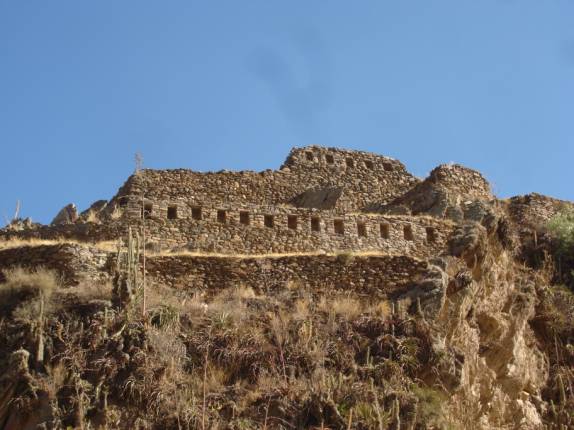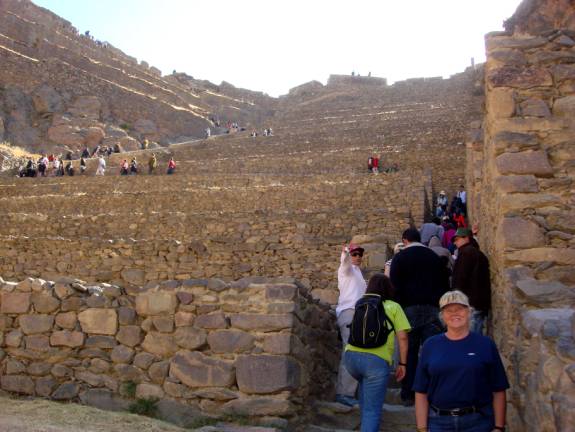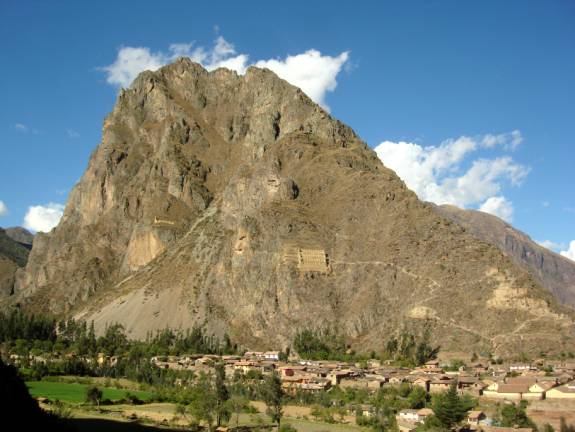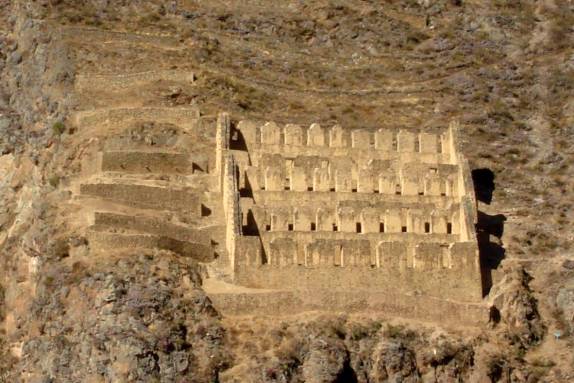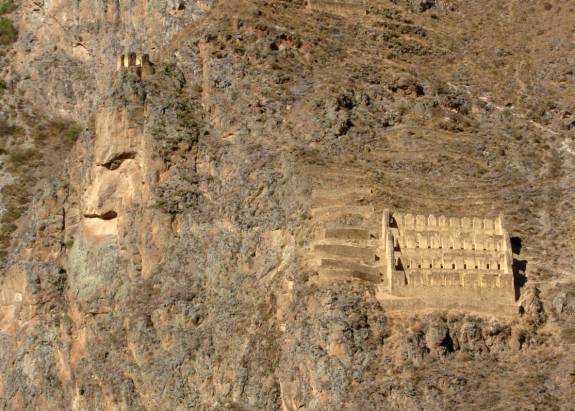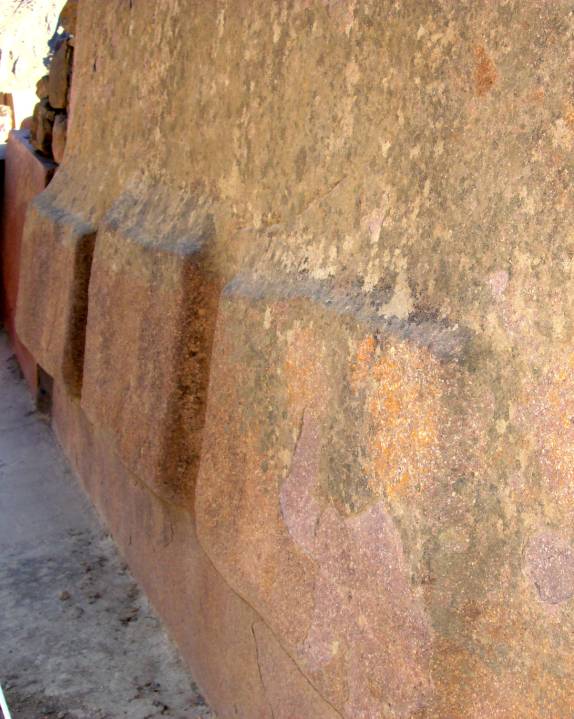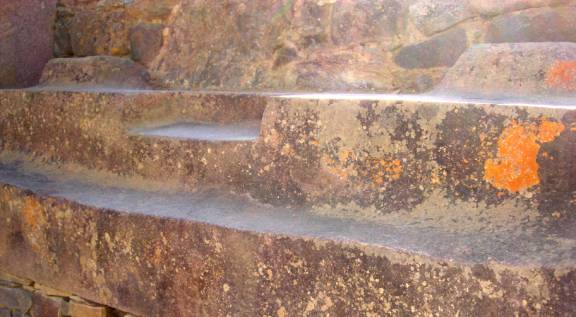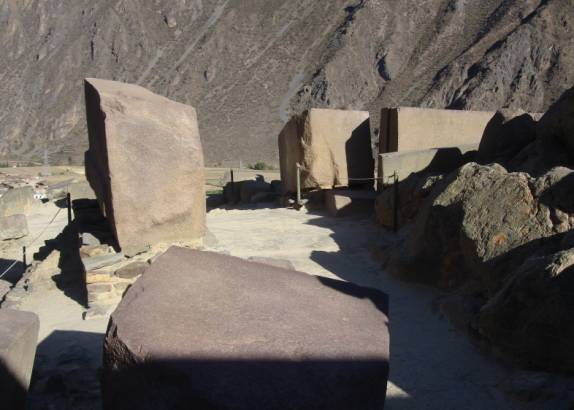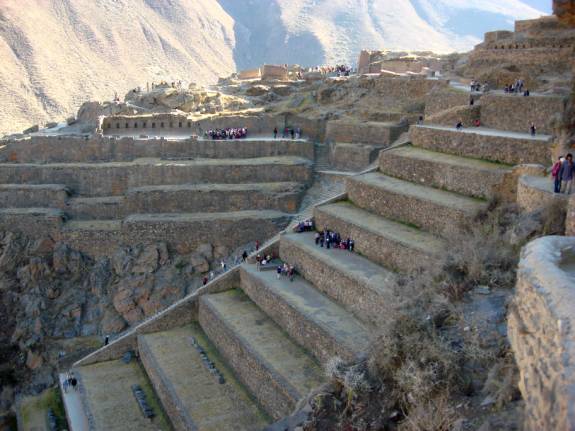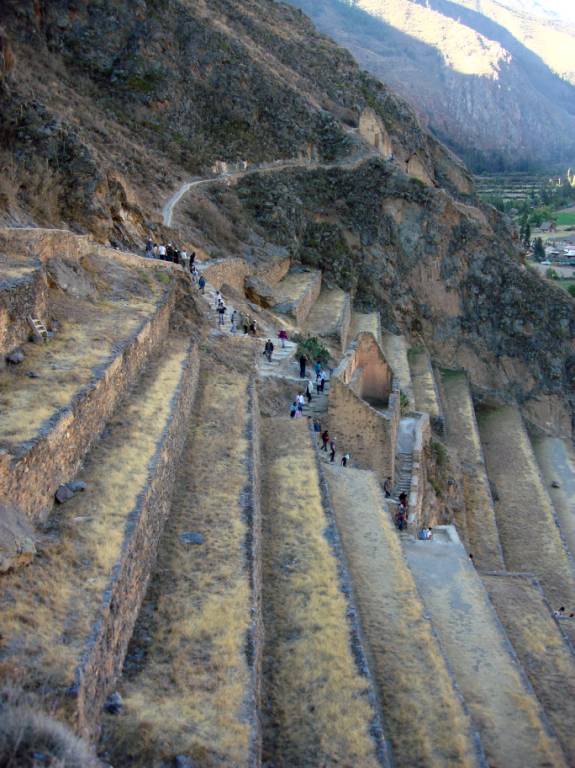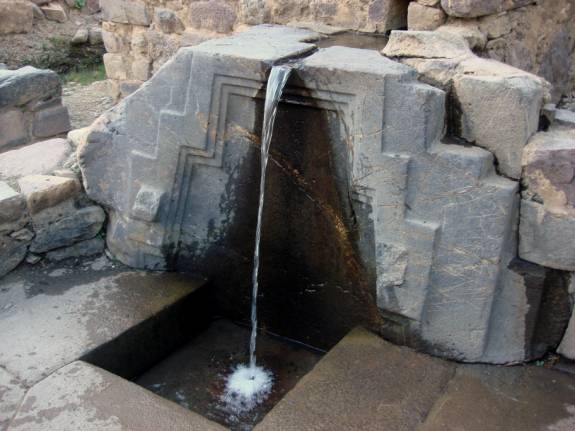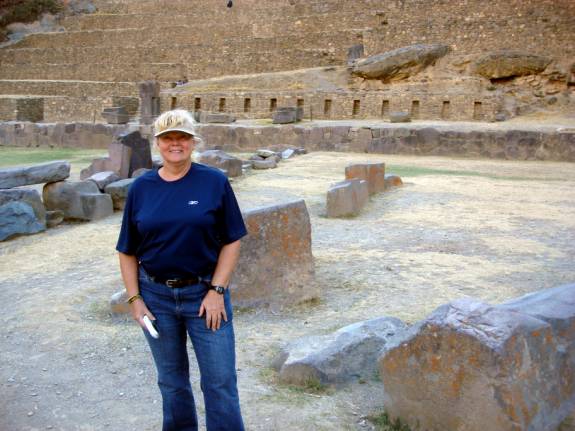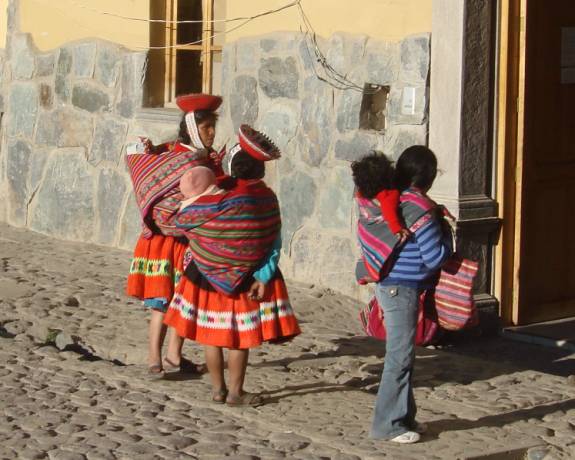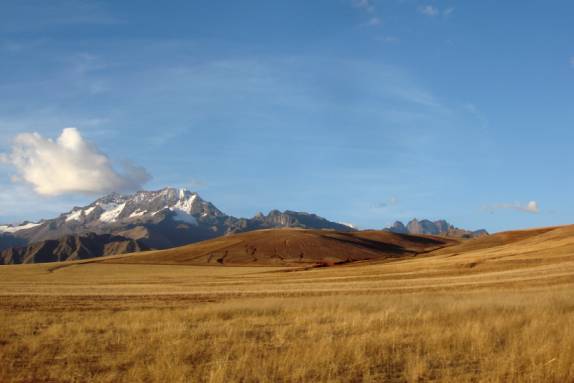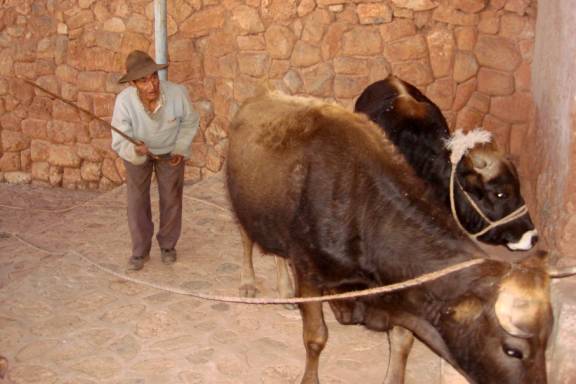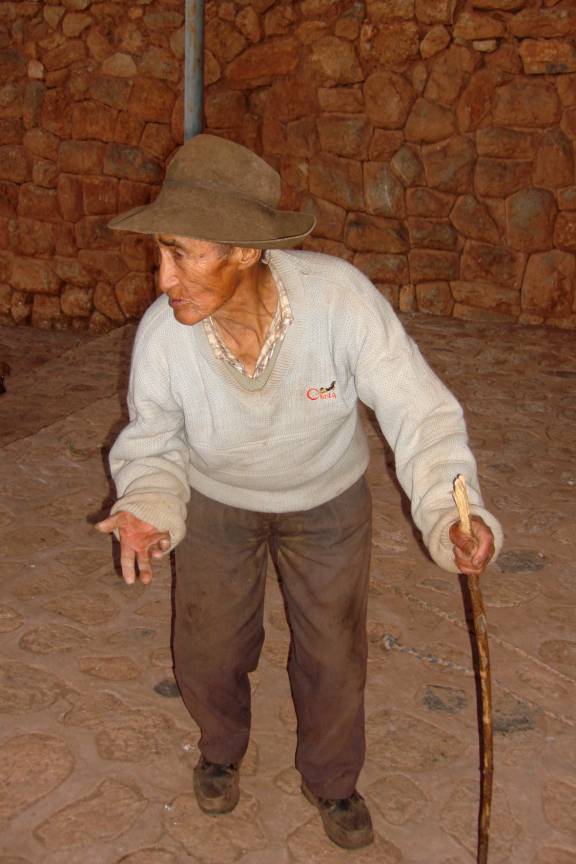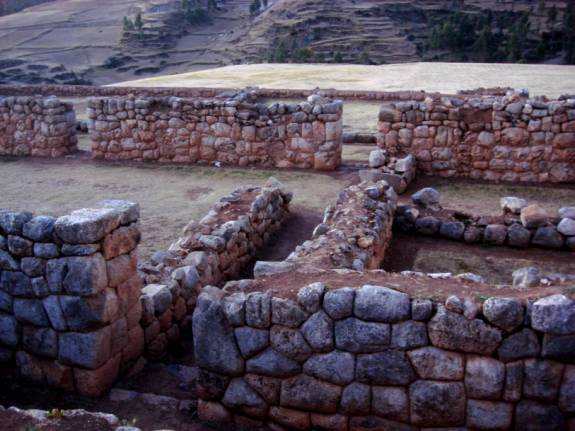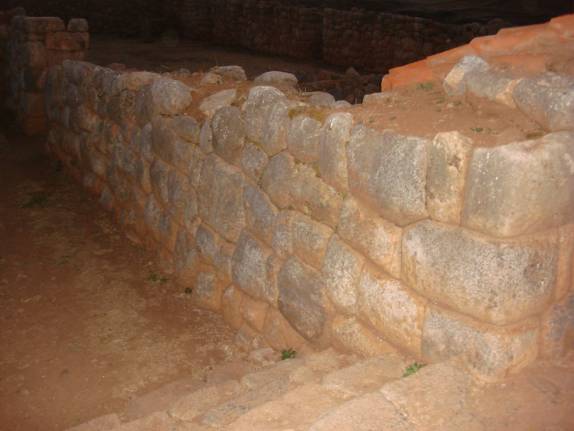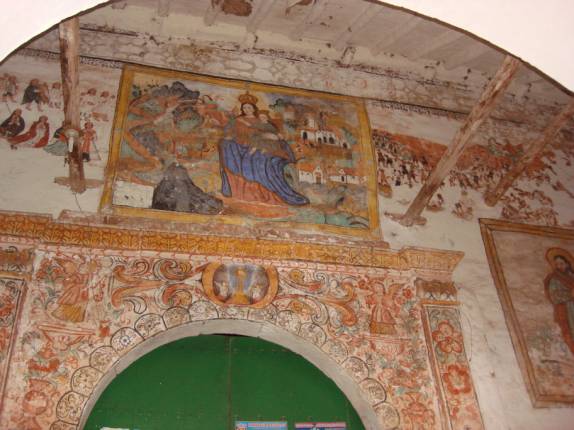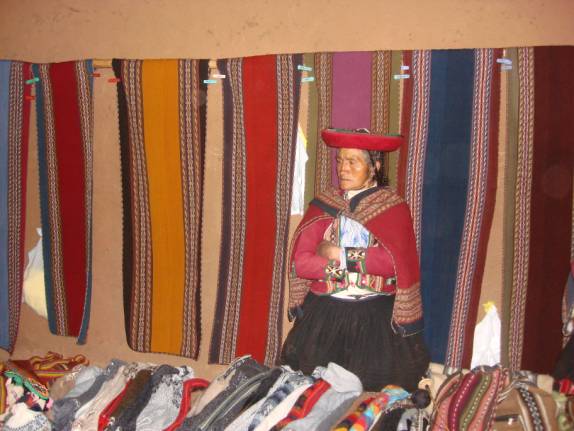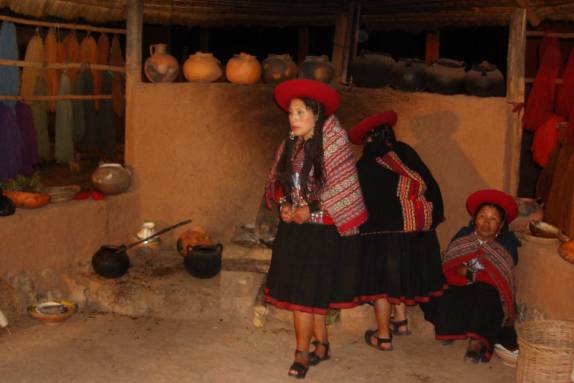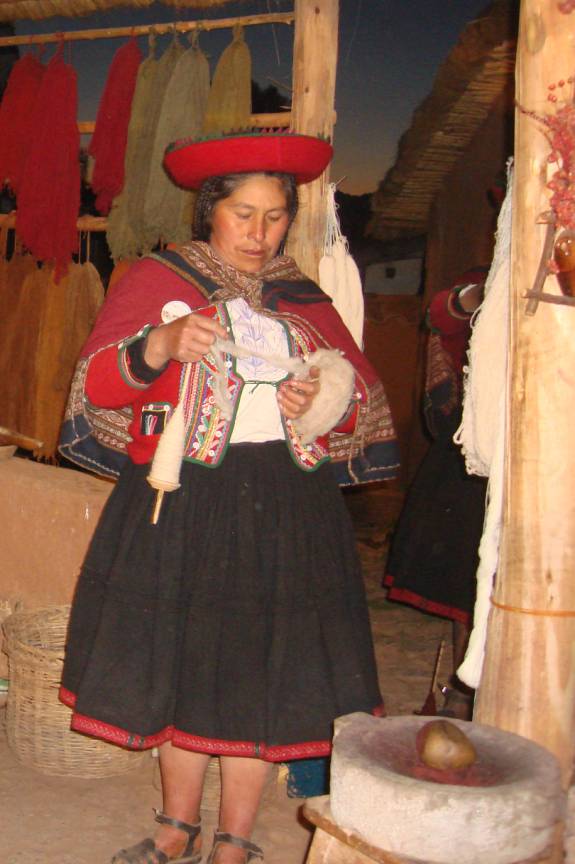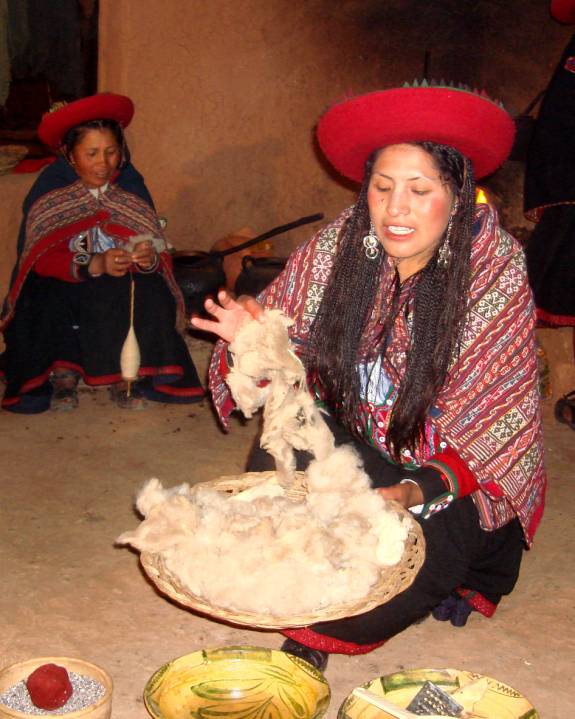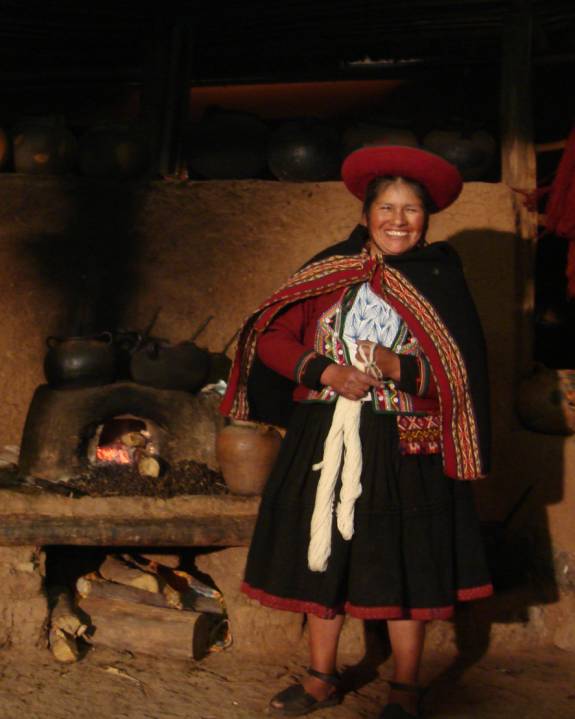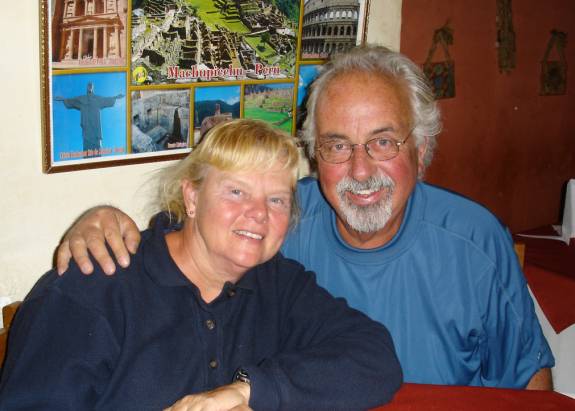|
|
|
|
Site Index:
|
UPDATE#19
08/21
thru 08/22/08
Howdy
Everybody, The
adventures of 2008 from 1/1/08 through 08/20/08 have been published on the
website.
We continue with the latest edition. UPDATE
2008 #19
08/21/08 through 08/22/08. At
last update, we were enjoying our adventure trip to Peru and our travels through
the Andes Mountains and the Central Highlands. 08/21/08
THURSDAY
ANDAHUAYLAS to CUSCO
The alarm clocks sounded at 5:30am.
Half an hour later, we were hailing a MotoTaxi to the Terminal Terreste.
We were surprised to see that the main road was strewn with rocks.
This appeared to be someone, or some group, attempting to disrupt the
flow of traffic.
Our MotoTaxi driver zipped over a small, wooden bridge to use an
alternate road.
The mountainous route from Andahuaylas to Abancay is a rough, dusty,
gravel road.
Our 6:30am bus was delayed until 7:45am due to the late arrival of a
connecting overnight bus from Ayacucho.
Perhaps a dozen people transferred to our bus for the continuation of
their trip eastbound.
The
bus was packed to overfull, requiring many to stand or, else, find someplace
wherever they could.
This young, Andean mother seemed to find her most comfortable spot in the
aisle and space next to Judy.
In Peru, the attitudes toward personal space differ from US standards.
North Americans usually have strong expectations requiring a lot more
personal space.
In Peru, like most other Central and South American countries, if any
space exists, they consider themselves fully entitled to make their own use of
it. If
you are going to travel in a foreign country, you must adopt the prevailing
standards that you will encounter.
With that said, you must also set the limits as to what space exists for
them or you will soon lose the space you thought you had.
Fortunately, Judy shared the space generously with this gal and her baby.
I love these pictures that show the snaky road that we are traveling on.
Moving back and forth along the gravel roadway permits the bus to
negotiate the steep terrain.
It frequently takes a lot of miles to make only a few miles toward our
destination.
If we had chosen to travel by airline from Lima to Cusco, the trip would
have only taken about an hour.
Our idea of adventure along these remote gravel routes required four full
days of rugged transportation.
To our way of thinking, our choice was, by far, the most interesting and
adventuresome.
Although we chose the right side seats, #19 and #20, I would recommend
the left side for a marginally better view of the striking mountain backdrop.
The bus started to experience some engine problems and the loss of power.
It may have been a fuel or filter problem for the diesel engine.
The driver and his helper made a couple of attempts before successfully
solving the problem.
After the city of Abancay, the roadway is paved with asphalt.
The scenery is still very beautiful and is still very curvy, however,
these last few hours are traveled much faster and smoother.
With the gentler ride, they put on a DVD movie.
“Titanic” showed in Spanish, however, no “palomitas” (popcorn)
was served.
The bus arrived at the central terminal in Cusco at 5:40pm.
A nice gal from Travel Connections met us at the station to assist us to
our hostal.
They provide the service for the opportunity to inform about their tour
services.
We were delighted that there was no hard sell.
Our reservation for the Hostal Coriwasi was ready and we were escorted to
our room #10.
It was a comfortable, rustic styled habitation that had a nice view and
the promise of peace and quiet.
Before long, we were off to catch some
evening sightseeing and choose a place for dinner.
Of course, the Cathedral was our place to visit since the doors were open
for evening mass. As usual, the décor
was artistic and ornate.
We found our choice for dinner along Calle Plateros.
The Haylly Café offered 6 or 7 fixed menu offerings at reasonable
prices.
Many of the other restaurants, especially near the Plaza, expect
exorbitant tourist prices.
We preferred a more economical approach.
The service was good, the food was good, and we were treated to some
local, Andean music.
Another added attraction to this place is the No Smoking dining room here
on the lower level.
After dinner, we walked and walked some more in an attempt to see more of
the city in lights.
The famous Inca Wall of Qorikancha is stunningly lit.
Following the Spanish conquest, the catholic colonial church and convent
of Santo Domingo was constructed directly over the Inca wall.
The beautiful bell tower of Santo Domingo church boldly stands out
against the night sky.
Just moments after I took this picture, the lights went off.
Feeling lucky, we located a nice casino to drop a few “centavos”.
For only a few bucks, we played the slot machines for well over an hour.
As usual, the house held the winning odds.
Our hostal is located up some pretty steep hills.
Generally, we walk down and choose to take a taxi for our return.
The taxi fare should be 3 Soles (just over $1 US) to anywhere in the
city, don’t pay more. 08/22/08
FRIDAY CUSCO – PISAC –
URUBAMBA – OLLANTAYTAMBO – CHINCHERO – CUSCO
To take maximum advantage of the daylight hours, we set our alarms for
6am. We
are enjoying this hostal and the showers were nice and hot.
Set on the side of a steep hill, the rooms are at various levels.
Lots of stone steps connect the various parts of the hostal.
At these higher altitudes, all the climbing can quickly zap your energy.
“Desayuno” (breakfast) is included in our rate and is served in a
dining room with a nice view and a fireplace to make it cozy.
The included fare consisted of Muesli cereal, yogurt, coffee, bread,
bananas, eggs to order, and delicious, freshly squeezed orange juice.
Wonderful colonial styled buildings with portico walkways surrounds the
main Plaza de Armas.
This is definitely one of the most beautiful cities in all of Peru.
We had decided to take our tours with Cusi Tours on Calle del Medio.
The “Valle Sagrado”, or “Sacred Valley” excursion departed at
8:20am.
We were the first ones on the 30-passenger bus giving us the first pick
of seats.
Although we chose the left side, I think the right side might have been
slightly better.
The bus maneuvered around the narrow streets of the city for passenger
pickups at numerous hotels.
By 9am, we were headed out on the excursion with “Lucho” as our
guide.
I’ll start out right away telling you that he was fantastic. His
English skills were excellent and he demonstrated an intimate knowledge of the
area and its history.
If you ever have the choice, this is the guy you want for your guide too.
Our first stop was a craft market and “pit-stop”.
Normally, I don’t enjoy these kinds of places, however, this one
exerted almost no pressure and the bathrooms were very clean and nice.
We also had a chance for some cute photos, proving that we are definitely
on the tourist circuit now.
From a roadside “Mirador” (viewpoint), we had an excellent chance to
see the richness of the Rio Urubamba Valley.
The ruins of Pisac are famous for the agricultural terracing which has
been cut into the mountainside. These incredible terraces can be seen from all
across the valley. Hiking paths above the terraced walls offer magnificent views
ranging the entire site and deep into the Urubamba Valley below.
Above the terraces, cliff-hugging footpaths, massive stone doorways,
steep stairways, and magnificently fitted-stone Inca Walls provide awe-striking
views of an ancient civilization.
"If music be the food of love, play on."
Shakespeare, Twelfth Night
Far below, the massive Urubamba Valley and River cut through the Andes
Mountains.
Upon reaching the summit, we viewed the major ceremonial center with the
Temple of the Sun, the “Intihuatana” (Hitching Post of the Sun),
and the sacred baths.
Lucho clearly explained the significance of the sacred ceremonial baths.
In Inca times, these pools contained clear mountain waters and were deep
enough for full body emersion.
One must be entirely cleansed before approaching the altars of the
highest deity, the Sun God.
Numerous intricately crafted walls, constructed of perfectly fitted
stones, have angular niches designed to hold religious artifacts or special
offerings to the Sun God.
No cement was used to hold these walls together.
The Inca relied on the near perfect geometric design features.
You can see that the walls are built up like interlocking puzzles, the
blocks perfectly fit together without the need for any cements.
At the Temple of the Sun, the exact purpose of the “Intihuatana” is
unknown. It is believed to have been some sort of an astronomical or
archaeological object. Most archaeological scientists think it was used for
determining the solstices by tracking the sun rays and reflecting them in
various ways.
Lucho used clever line drawings in the sand to explain the currently
accepted views about the Inca people’s knowledge of astronomical events.
He also pointed out the importance of this location in relation to the
other mountain land features in the vicinity.
The way the sun would appear against the other major peaks and the exact
distances between other important sites were all part of the Inca plan.
His descriptions were fascinating.
Unfortunately,
the Písac “Intihuatana” stone was brutally smashed by the Spanish invaders.
This destruction happened to all of the sacred Inca stones, except for the Machu Picchu Intihuatana,
which the Conquistadores never found.
The footpaths and steep stair steps were physically demanding at these
high altitudes.
I am quite proud and pleased that Judy and I could do so well in these
elevations and locations.
Down in the valley, the town of Urubamba was selected for our lunch.
Included in the price of our tour, a nice buffet was open for our
enjoyment.
Everything was fresh and delicious.
Playing a variety of native Peruvian instruments, this Andean musician
entertained at the luncheon.
The pan flute is the main instrument of the region; there are many
different sizes and shapes that create a range of sounds and tones.
Other types of flutes, rain sticks, and shell rattles enriched the
musical experience.
After lunch, the tour continued to the next site.
Ollantaytambo
is an important Inca archaeological site some 60 kilometers northwest of Cusco
and is located at an altitude of 2,792 meters above sea level.
During the Inca Empire, Ollantaytambo was the royal estate of Emperor
Pachacuti who conquered the region, then built the town and the ceremonial
center. At the time of the Spanish conquest of Peru, it served as a stronghold
for Manco Inca Yupanqui, leader of the Inca resistance.
Up on Cerro Bandolista, a steep hill rising sharply from the town, the
Incas built their elaborate ceremonial center.
The part of the hill facing the town is occupied by the terraces of “Pumatallis”,
framed on both flanks by rock outcrops. Due to the impressive character of these
grand terraces, the Temple Hill is commonly known as the Fortress, however, this
is probably a misnomer as the main functions of this site were religious. The
main access to the ceremonial center is a series of stairways that climb to the
top of the terrace complex.
The Incas built several
storehouses (Quechua: qollqa) out of fieldstones on the hills surrounding
Ollantaytambo. In their location at higher altitudes, there is more wind and
ambient temperatures are lower, thus protected the contents against rot and
decay. Enhancing this effect, the special storehouses featured elaborate
ventilation systems. Most likely, the structures were erected as a means to
store the production from the agricultural terraces around the site.
It is probably easy for you to see the face of the man in the side of
this mountain.
The Inca saw it clearly and it was highly revered, possibly even as a
God. The
stone buildings atop the head give the appearance of a crown.
The Temple sector is built out of cut and fitted stones in contrast to
the other two sectors of the Temple Hill which are made out of fieldstones.
The precision cuts of these massive stones still amazes archaeologists
who have yet to determine the exact methods used by the Inca in their
construction.
…the Platform of the Carved Seat.
The main structure of the sector is the Sun Temple, an uncompleted
building featuring the spectacular, "Wall of the Six Monoliths".
The unfinished structures at the Temple Hill and the numerous stone
blocks that litter the site indicate that it was still undergoing construction
at the time of its abandonment. Some of the blocks show evidences of having been
removed from finished walls, which suggests evidence that a major remodeling
effort was also underway
…a few of the terraces at Temple Hill.
Although it
is unknown which specific event halted construction at Temple Hill, the most
plausible speculations include a raging war between Inca rival brothers, Huáscar
and Atahualpa, for succession of power, the Spanish Conquest of Peru, and the
subsequent retreat of Manco Inca from Ollantaytambo to Vilcabamba.
These extensive terraces permitted farming on otherwise unusable terrain;
the Incas took advantage of the different ecological zones created by variations
in altitude. At Ollantaytambo, the terraces were built to a higher standard than
common Inca agricultural terraces, for instance, many have higher walls made
with cut stones instead of rough fieldstones.
Once again, the number of steps that we managed to climb absolutely
amazed us.
We succeeded where many much younger visitors gave up.
We persevered and we were well rewarded by the magnificence and grandeur
of this special place.
This ceremonial bath was used to cleanse the body to become worthy to
approach the sacred temple.
The damaged handholds at either side of the water were used in the
ritual.
Many of the ancient customs and beliefs of the native people have
remained unchanged for centuries.
Our tour continued with the bus climbing to the high plains and the
village of Chinchero.
At 3762 meters (12,343 feet), this typical Andean village is at an
elevation almost 400 meters higher than Cusco.
The Incas believed that this was the birthplace of the rainbow.
The steep streets of the village are busy with everyday Andean life.
The most striking remnant of this period is the massive stone wall in the main plaza, which has ten trapezoidal niches. The construction of the wall and many of the building ruins, as well as the historic agricultural terraces, are attributed to Inca Tupac Yupanqui (circa 1480). Some archaeologists surmise that Chinchero might have been a sort of "vacation spot" for the Inca ruler, Tupac Yupanqui.
It is said that the ruler was killed here, perhaps poisoned
by his mistress, Chiqui Ocllo or Mama Ocllo. The son of Inca Tupac Yupanqui,
called Capac Huari, was held here imprisoned for his entire life until he died.
The destruction of Chinchero began when Manco Inca, after his campaign in
Cusco, decided to discharge his soldiers so that they could go back to their
farmlands and take care of their families; he went towards Ollantaytambo passing
through Chinchero and burning it so that the Spanish invaders who were pursuing
and persecuting him could not have either food or lodging.
In 1572, Viceroy Toledo founded the "Doctrine of Our Lady of
Montserrat of Chinchero" and ordered construction of the present-day
Catholic Church that was finished by early in the 16th century; most probably in
1607, that is the year found in the writing over the main arch inside the
church. The whole church
was built using, as foundations, the finely carved stones that belonged to a
great Inca palace. The major portions of the Inca buildings were covered to the
roofs with fill dirt brought from some other areas. In the 1960s, the Inca
palace was discovered buried under the Catholic Church. The uncovered ruins
contained an opening with a “triple jam” that is indicative of a very
important Inca palace.
Fresco paintings at the church tell stories of Christian glory and Incan
strife.
Chinchero has a very active community of highly accomplished weavers.
Their mantas (shawls) are hand woven on traditional back strap looms.
Our tour group was invited to attend an informative session about their
methods and practices.
In fine native dress, typical of the Chinchero women, this very
intelligent spokesperson gave her demonstrations in fluent English.
She speaks at least three languages, including Spanish and her native
Quechua.
Abandoning modern equipment and yarns, these talented crafts persons have
revived the same traditional and ancient techniques used by their
ancestors.
Using only hand-spun wools, primarily from Alpaca animals, the yarns
are colored with traditional natural dyes made of herbs and plants.
Beautiful red colors are created from a fungus that grows on the pear
cactus plants.
Other colors come from boiling herbs and various plant substances.
Their methods are obviously more difficult and time consuming ways to
produce these fine crafts, but these women are sincerely devoted to keeping the
ancient skills and traditions alive.
Although both of these women are skillful “Weavers”, only the gal in
blue has the talent to weave my dreams into wonderful reality.
It was after 7:30pm when we returned to Cusco after our very full day of
adventure.
We selected the Andes Café on Calle Procuradores.
It was recommended in someone else’s blog site and we decided to follow
their advice.
We found it to be a good and economical dinner spot.
Although the Mexican specialties were quite different than our
pre-conceived ideas, they were tasty.
The lovely fountain in the center of the Plaza de Armas was operating
tonight.
Often times, the waters are still and silent.
A tuckered out Fred and Judy were happy to taxi up to the
hotel.
Drifting off to sleepy dreamland came quickly and soundly. TO
BE CONTINUED…SOON…
Please let us know if you have any special suggestions and thoughts. Thanks
for allowing us to share our life and adventures with you. Lotsa
Luv, Fred
Reed and Judy Law AMARSE "AMARSE". is pronounced "AM-ARE-SAY". Our website is: www.amarse.net .
|
|
Fred H. Reed |
www.amarse.net © 2006 2007 2008 2009 2010 2011 |


